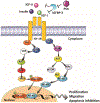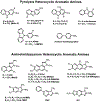Dietary Carcinogens and DNA Adducts in Prostate Cancer
- PMID: 31900903
- PMCID: PMC7203629
- DOI: 10.1007/978-3-030-32656-2_2
Dietary Carcinogens and DNA Adducts in Prostate Cancer
Abstract
Prostate cancer (PC) is the most commonly diagnosed non-cutaneous cancer and the second leading cause of cancer-related to death in men. The major risk factors for PC are age, family history, and African American ethnicity. Epidemiological studies have reported large geographical variations in PC incidence and mortality, and thus lifestyle and dietary factors influence PC risk. High fat diet, dairy products, alcohol and red meats, are considered as risk factors for PC. This book chapter provides a comprehensive, literature-based review on dietary factors and their molecular mechanisms of prostate carcinogenesis. A large portion of our knowledge is based on epidemiological studies where dietary factors such as cancer promoting agents, including high-fat, dairy products, alcohol, and cancer-initiating genotoxicants formed in cooked meats have been evaluated for PC risk. However, the precise mechanisms in the etiology of PC development remain uncertain. Additional animal and human cell-based studies are required to further our understandings of risk factors involved in PC etiology. Specific biomarkers of chemical exposures and DNA damage in the prostate can provide evidence of cancer-causing agents in the prostate. Collectively, these studies can improve public health research, nutritional education and chemoprevention strategies.
Figures






References
-
- Torre LA, Bray F, Siegel RL, Ferlay J, Lortet-Tieulent J, Jemal A (2015) Global cancer statistics, 2012. CA Cancer J Clin 65: 87–108 - PubMed
-
- Bostwick DG, Burke HB, Djakiew D, Euling S, Ho SM, Landolph J, Morrison H, Sonawane B, Shifflett T, Waters DJ, Timms B (2004) Human prostate cancer risk factors. Cancer 101: 2371–490 - PubMed
-
- Perdana NR, Mochtar CA, Umbas R, Hamid AR (2016) The Risk Factors of Prostate Cancer and Its Prevention: A Literature Review. Acta Med Indones 48: 228–38 - PubMed
Publication types
MeSH terms
Substances
Grants and funding
LinkOut - more resources
Full Text Sources
Medical

